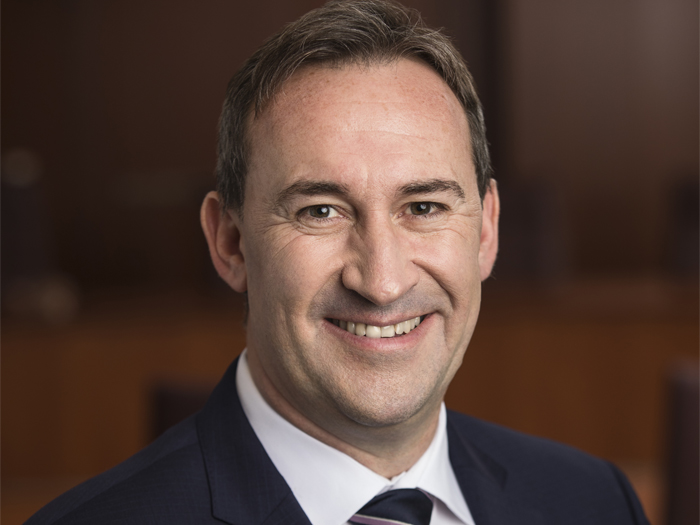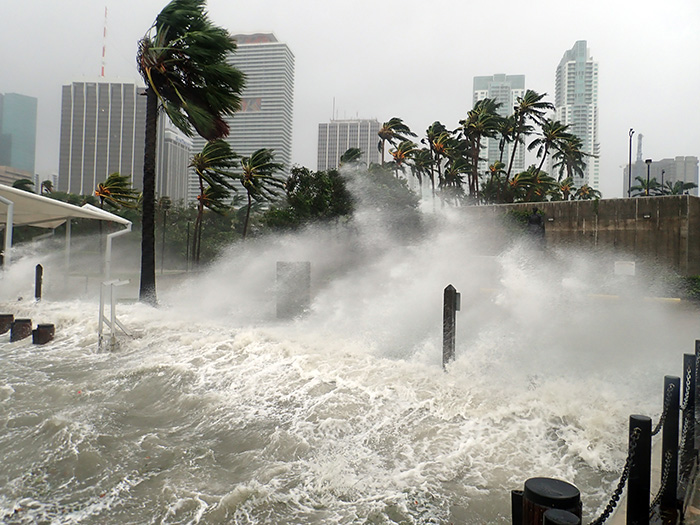Malcolm Roberts on FM Global’s Robust Financial Position and Future Plans

At RISKWORLD 2024 in San Diego, Dan Reynolds, editor-in-chief of Risk & Insurance, caught up with Malcolm Roberts, chairman and CEO of FM Global. What follows is a transcription of their discussion on FM Global’s financial performance, membership credit announcement, resilience credit program, and upcoming launch in the renewable energy sector.
Risk & Insurance: FM Global recently reported strong financial performance and momentum for 2024. Could you provide your perspective on the company’s current position?
Malcolm Roberts: FM Global is in the strongest financial position it has ever been. While I’d like to take credit for that, it’s really thanks to our clients.
We have an elite group of clients who are incredibly focused on risk management. Just last year, they completed risk improvement recommendations that reduced loss expectancy by nearly $1 trillion, with over 40,000 risk improvement recommendations implemented.
Our clients are doing everything they can to mitigate against losses, whether from catastrophes or other risks. As a result, we ended up with a 67% combined ratio, which is a testament to the great work they’re doing.
R&I: What is the significance of FM Global’s recent membership credit announcement?
MR: The announcement is particularly special as it coincides with FM Global’s 25th anniversary as a merged company. In the past two years, despite a challenging market, we have given back nearly $3.5 billion in membership and resilience credits, which equates to 80% of our underwriting profit.
As a mutual company owned by our clients, our goal is to maintain a circle of resilience. When our clients invest in loss prevention and achieve good results, we invest the majority of our underwriting profit back into them.
Since becoming FM Global in 1999, we have grown from $2 billion in capital and $1 billion in premium to nearly $25 billion in capital and $11 billion in premium. This growth is a testament to our clients’ commitment.
To recognize this milestone and our clients’ loyalty, we enhanced our normal membership credit by increasing every bracket by at least 25% and creating a special 25-year category. This demonstrates our strength and dedication to giving back to our clients.
The total value of this credit is approximately $1.4 billion; our normal credit amount is around $800 million. It’s a well-earned and well-deserved reward, and we hope to continue this cycle for many years to come.
When our clients invest in loss prevention and perform well, it means we are also doing well. Ultimately, as a mutual company, it’s their money. The beauty of the mutual structure is that we are not giving profits to outside shareholders; instead, our policyholders are our owners.
This financial strength provides a platform for product innovation and allows us to offer benefits like this membership credit.
R&I: What is a resilience credit and how does it differ from a membership credit?
MR: We offer both types. The membership credit is based on the length of time a client has been with us, or as we like to say, “years in the club.” Our philosophy is that the longer a client has been with us, the more they have likely invested back into the model of loss prevention. We reward this loyalty with a higher credit percentage for longer tenures.
On the other hand, the resilience credit is not tied to the duration of a client’s membership. Instead, we have targeted it to address specific risks, particularly climate-related risks, which are a significant concern for our clients.
A couple of years ago, we introduced the resilience credit alongside a new AI-driven analytics climate tool. This tool not only maps a client’s climate risk but also provides actionable recommendations from FM Global’s engineering team on how to mitigate those risks.
Here’s how it works: We provide our clients with an analytic showing their climate risk exposure, and then we contribute 5% of their premium as a resilience credit. While we don’t mandate how they use this credit, we strongly encourage them to direct it towards climate risk mitigation efforts.
The results have been impressive. Across the two resilience credits we’ve offered so far, our clients have utilized approximately $650 million to eradicate $35 billion of climate exposure from their portfolios. To put this into perspective, the insurance industry has attributed over $100 billion of property loss to climate risk in recent years.
While climate-related events will always happen, I feel more confident that our clients are well protected against them and will come out of these situations much better than if they hadn’t invested in risk reduction. It’s important to note that our clients have also invested a lot more than just the money we’ve provided.
When you present a CEO or CFO with 10 solutions to improve their climate risk, totaling $1 million, and explain that FM Global has contributed $300,000 towards those solutions, it becomes clear that it’s a smart investment. They simply can’t afford a flood of that critical magnitude, so spending a million dollars on prevention is a wise decision.
Interestingly, the resilience credit has resonated more with our client base because it’s tangibly tied to risk improvement. We consider the resilience credit and membership credit as mutually exclusive, so some years we might offer one, the other, or both. Overall, it’s been a great initiative for reducing our clients’ exposure to climate risks.
R&I: Could you tell us about FM Global’s upcoming launch in the renewable energy space?
MR: We are on the cusp of a significant launch in the renewable energy sector. FM Global recognizes the growing importance of sustainable energy solutions and the unique risks associated with these projects.
Our team has been diligently working to develop comprehensive insurance products tailored to the needs of renewable energy companies. By leveraging our extensive expertise in risk management and our deep understanding of the industry, we aim to provide unparalleled support to our clients in this rapidly evolving field.
Through this launch, we are committed to helping renewable energy businesses protect their assets, minimize downtime and navigate the complex challenges they face. We believe that our innovative approach and customized solutions will set a new standard in the industry and contribute to the growth and success of the renewable energy sector.
R&I: What makes FM Global’s approach to insuring power generation facilities unique in the industry?
MR: FM Global has been in the power generation insurance business for 70 years. This longevity has allowed us to develop a deep understanding of the unique risks associated with these facilities.
Our approach is distinguished by our extensive experience and expertise in this sector. We leverage this knowledge to provide tailored insurance solutions that address the specific needs of power generation clients.
After being in this business for such a long time, we have gained invaluable insights into the evolving landscape of power generation. This enables us to stay ahead of emerging risks and offer proactive risk management strategies to our clients.
FM Global insures power generation clients representing nearly $1 billion in premium. Our portfolio includes world-class power operators in fossil fuels, as well as a significant number of clients in clean energy sectors such as hydro, biomass and waste-to-energy.
Notably, more than half of our power generation clients are already in the process of transitioning to renewable energy sources. We have extensive experience supporting clients through this transition, providing risk management solutions tailored to their evolving needs.
R&I: What led FM Global to create a new product specifically for the renewable energy sector?
MR: The world is moving towards renewable energy, and we need to stay relevant by offering a product that brings insight and risk management expertise to this sector. While we had some renewable energy clients in our current portfolio, we recognized the need for a different product tailored to their specific needs.
We have our mutual product for highly protected risks and our middle-market AFM, which is a stock company. The renewables business unit will be a stock company as well, but owned by the mutual, not publicly traded. By leveraging our knowledge of how to protect energy infrastructure, we can provide valuable services to renewable energy companies as they continue to grow and innovate.
Renewable energy is a volatile business, especially when it comes to technologies like solar and wind’s vulnerability to hail damage. The industry that insures this space is running well above a 100% combined ratio, meaning they are losing money.
At FM Global, we took a step back and decided we didn’t want to simply provide capacity as a player in this market. Instead, we aimed to bring value to our clients by defining what a “highly protected renewable risk” looks like.
To achieve this, we began researching the science, engineering standards and best practices in the renewable energy sector three years ago. Through this process, we developed a set of approvals and guidelines to help mitigate the risks associated with these projects.
For instance, when a solar panel is subjected to hail, our standards ensure that it doesn’t crack and can withstand impacts of certain sizes. Our goal is to provide a comprehensive suite of true FM Global engineering value to our clients.
We now offer a dedicated insurance policy with specific coverages tailored to the unique needs of the renewable energy sector. This is complemented by our distinctive engineering offerings, which leverage data analytics and our field and account services.
By bringing all these elements together, we aim to build a resilient future for our clients, not just for the next 2 or 5 years, but for the next 20 years and beyond as we navigate the transition to renewable energy.
The renewable energy market today is similar to the cyber insurance market a decade ago. Everyone is eager to enter the space, but it’s being done at unsustainably low prices, often below the burning cost. As a result, we’re seeing losses in the sector.
At FM Global, we take a long-term, strategic approach. We aim to set standards for the next three years and then work towards implementing them. This allows us to establish a strong foundation and position ourselves for success as the market matures and evolves.
R&I: What are some of the side benefits of ESG initiatives, beyond just checking boxes for compliance?
MR: ESG initiatives offer more than just compliance benefits. For example, when a company invests in protective measures to renew their insurance policy with FM Global, they can also receive ESG credit.
This demonstrates how risk management and sustainability efforts are often interconnected. By taking proactive steps to mitigate risks, companies simultaneously improve their ESG standing, which can lead to positive outcomes like enhanced reputation and investor confidence.
R&I: What role does data and technology play in FM Global’s underwriting process and risk assessment?
MR: Data and technology are integral to our underwriting process and risk assessment at FM Global. We leverage advanced analytics and modeling techniques to gain deeper insights into the risks our clients face.
By harnessing the power of data, we can better understand the unique characteristics of each client’s business and tailor our insurance solutions accordingly. Technology also enables us to streamline our underwriting workflows, improving efficiency and accuracy.
Ultimately, the combination of data and technology allows us to make more informed decisions, provide superior risk management advice to our clients and deliver the best possible insurance solutions to meet their needs.
R&I: What areas are you looking to innovate or invest in for the future, beyond what you’ve already mentioned?
MR: There are plenty of areas we’re focusing on. AI is a key area where we can use analytics to enhance our current fire science and climate risk assessment. We’re not just looking at the hazards of today, but also predicting where these risks will be 5 to 10 years from now.
Climate is no longer static; it’s dynamic. Like many others, we’ve been investing in AI for a number of years. We’re exploring ways to leverage AI and machine learning to better understand and predict climate-related risks.
This will allow us to provide more accurate and timely insights to our clients, helping them make informed decisions about risk management and resilience planning. By staying at the forefront of these technological advancements, we aim to continually improve our services and support our clients in navigating the evolving risk landscape.
R&I: What do you believe will be the key differentiator for FM Global in an industry where many companies are adopting new technologies and marketing strategies?
MR: I believe the true differentiator for FM Global will be our data. Our location-based model provides us with an immense wealth of data and knowledge.
New tools like quantum computing allow us to gain even more insights from that data, enabling us to offer enhanced services to our clients. Additionally, we are always closely monitoring climate risk and its potential impacts.
Furthermore, as my chief science officer points out, the ongoing electrical revolution, including advancements like small nuclear reactors and solar power, will require a whole new grid and infrastructure. While fire protection might not seem as glamorous as it once did, it’s important to remember that the number one cause of fire is already electrical in nature.
As we redesign electrical systems around the planet for the next generation, FM Global’s expertise in fire protection will become increasingly crucial. We are well positioned to address the challenges and risks associated with this electrical revolution.
R&I: What are some of the key trends you’re seeing in the commercial property insurance market, and how is FM Global responding to these trends?
MR: The commercial property insurance market is experiencing several notable trends. One significant trend is the increasing frequency and severity of natural catastrophes, which have led to substantial losses for insurers in recent years. FM Global is responding to this trend by leveraging our extensive engineering expertise and risk management services to help clients mitigate their exposure to natural hazards.
We work closely with our clients to assess their risks and implement loss prevention measures, such as improving building resilience and developing comprehensive business continuity plans. By taking a proactive approach to risk management, we aim to minimize the impact of natural catastrophes on our clients’ operations and bottom line.
Another key trend is the rapid pace of technological change and the emergence of new risks, such as cyber threats and supply chain disruptions. FM Global is investing heavily in research and development to stay ahead of these evolving risks and develop innovative solutions for our clients.
For example, we have developed advanced analytics tools that enable us to better understand and quantify cyber risks, as well as provide tailored risk management recommendations to our clients. We are also working with our clients to build more resilient supply chains by identifying potential vulnerabilities and implementing risk mitigation strategies.
Overall, FM Global remains committed to providing our clients with the expertise, tools and resources they need to navigate an increasingly complex and challenging risk landscape. By staying at the forefront of industry trends and investing in innovation, we are well positioned to deliver long-term value to our clients and support their success in the years ahead. &










